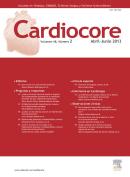
What is the role of surgery in thromboembolic pulmonary hypertension? Pulmonary endarterectomy
Eingesendet von Dr. Carlos Porras in Cirugía Cardiaca
Erstellt am Mo 01 Juli 2013 06:00
Und mit folgenden Tags versehen: pulmonary hypertension , endarterectomy , acute pulmonary embolism , NYHA , cardiac surgery
«What is the role of surgery in thromboembolic pulmonary hypertension? Pulmonary endarterectomy»
Carlos Porras, Hans-Joachim Schäfers
Cardiocore 2013; 48:65-8.

Chronic thromboembolic pulmonary hypertension (CTEPH) is an infrequent sequela of acute pulmonary embolism that develops in 1 to 4% of individuals, in whom thrombus material is not dissolved but organized into scar tissue. Remodeling of previously unaffected pulmonary arteries ensues, the patients develop progressive pulmonary hypertension (PH) and right heart failure. The diagnosis can be confirmed by ventilation/perfusion scanning and CT. Pulmonary angiography will give additional information, in particular with respect to central extension of scar. The administration of pulmonary vasodilators is of limited value in CTEPH. On the other hand, this disease can be treated causatively by pulmonary endarterectomy (PEA).
The operation requires a a high degree of precision. The chest is opened via a median sternotomy and the patient cooled to a nasopharyngeal temperature of 20°C. The central pulmonary arteries are opened, and a closed endarterectomy of the involved pulmonary arterial bed is performed. Postoperative intensive care involves careful management to avoid complications related to residual PH.
With careful patient selection the hospital mortality is less than 5% in patients with preoperative heart failure class III NYHA. The hemodynamic and clinical results are impressive. Pulmonary vascular resistance is markedly reduced within the first 48 hours, and a further reduction if often seen in the subsequent weeks. The patients are drastically improved in their exercise ability; in the majority of patients the hemodynamic and clinical improvement persists beyond 5 years postoperatively.